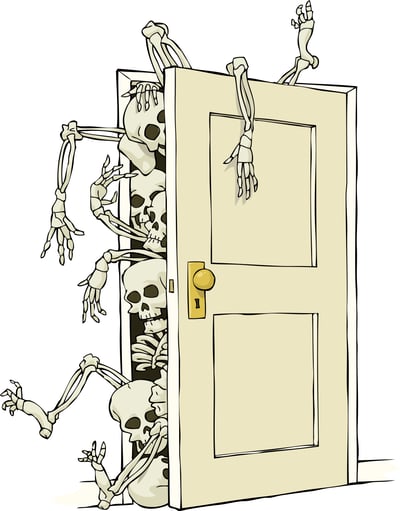In a perfect world, all your past project implementations will have gone exceedingly well, and the lessons learned from them would all be constructive and positive. Effective strategies from the past would then be reviewed and systematically applied to the present. 
But we don’t live in a perfect world, do we? In fact, over the course of my 35+ years in change management consulting, what I see in most organizations is a virtual cemetery of dead and buried projects. You know the ones I’m talking about, right?
Your Past Can Haunt You
Unfortunately, these skeletons in your closet can linger on in the memories of an organization for a very long time and will more than likely re-surface as resistance to change for your current project. Either consciously or sub-consciously people will always ask, “Why will things be different this time?”
Adding insult to injury, they may be right. The fact is, past problematic behaviors are likely to be repeated because whether we like to acknowledge it or not, these behaviors represent a success pattern. Every time you see a behavior, there either was, or there is a reward for that behavior. It can be a never-ending cycle that can be difficult to break.
One of the principles of the AIM Change Management Methodology is that a key factor in predicting the likelihood of future implementation success is the pattern of implementation results achieved during previous projects. That’s the reason why there is great value in looking at past history as part of your change management process.
The clear lesson here is that for change success, you must make a conscious effort to understand the patterns and impacts of past practices in order to be successful in the present and future.
Implementation History Assessment
IMA’s Implementation History Assessment (IHA) provides an overall indication of the prospects for current implementation success by identifying strengths to be reinforced as well as barriers to be mitigated based on your past history. The data comes from the responses of company employees regarding their personal experiences from the past 18 months to 3 years based on the following ten key measurement areas:
- Structure - Is your organization’s structure capable of promoting change? Do people understand the lines of authority?
- Stress – What is the current level of stress in your organization? Too much stress can point to a need for prioritization and improved resource allocation.
- History –What is your implementation culture? What are the positive and negative characteristics from past implementations?
- Sponsorship – How does your management lead changes? (This is the most influential segment and is linked to communication and reinforcement.)
- Readiness – Are your Targets ready to change? Do you have plans in place to identify and manage the inevitable resistance to your change projects?
- Cultural Fit – Does this change fit into your current culture? Are you attempting to bring in a change that flies in the face of your current operating norms?
- Agent Capacity – Do the Targets and Sponsors of the change trust the Change Agents? Do your Change Agents have the necessary skills, traits, and characteristics to work with Sponsors and to manage resistance?
- Reinforcement – Do positive rewards and negative consequences for non-performance currently exist? How are they applied?
- Communication – Does communication in the organization provide clarity of objectives and expectations at all levels?
- Involvement – Are your employees involved in “how to implement”?
Use the Data to Mitigate Risks
Data from the Implementation History Assessment gives you a snapshot of your current culture. It measures perceptions of past patterns of implementation results. If you know what those perceptions are you can predict what you will likely be coming up against for your current change. Once you have this data you can put strategies and tactics in place to help create:
- Project Prioritization
- Barrier Mitigation Plans
- Resistance Plans
- Communication Plans
- Sponsor Contracts
- Opportunities for Target Involvement
Albert Einstein once said, “The definition of insanity is doing the same thing over and over and expecting different results.” Yet managers typically will use the same strategies in the future that they have used in the past, unless a conscious effort is made to understand the patterns and impacts of past implementation practices. Not only is transparency around past failures critical to building credibility for the future, but lessons from past successes can also benefit future projects. In other words, you can't change history, but you can certainly learn from it!


